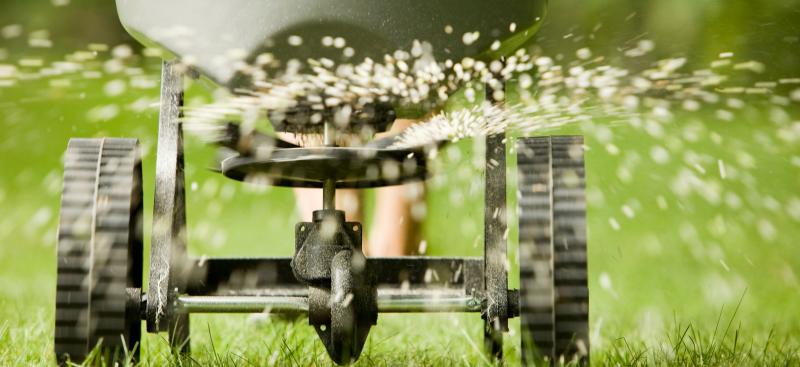Fertilizing your lawn the right way can make a big difference for Florida’s water quality. When fertilizers are applied incorrectly, they can wash into nearby water bodies, harming ecosystems and diminishing water quality. This guide will help you understand the best practices for fertilizing responsibly, following local regulations and protecting Florida’s unique environment
Why Fertilizing Responsibly Matters

More than 1,000 new residents move to Florida daily, many of whom take pride in maintaining beautiful lawns along with long-time Floridians. However, fertilizers contain nutrients like nitrogen and phosphorus, which, in excess amounts, can harm Florida’s natural water systems. Excess nutrients from fertilizers can wash into lakes, rivers, springs, estuaries and other water bodies causing:
- Algae blooms that reduce water clarity and create extreme fluctuations in dissolved oxygen
- Stress on aquatic life, including fish, amphibians and insects
- Long-term damage to Florida’s ecosystems
By following simple guidelines, you can:
- Protect Florida’s water bodies and natural ecosystems
- Support your lawn’s growth without over fertilizing
- Avoid violations for not adhering to local fertilizer restrictions
Steps to Fertilizing Responsibly

Step 1: Check Local Fertilizer Regulations
Timing is everything. When to fertilize depends on your lawn’s growth cycle and local restrictions. April and May are generally the ideal time to fertilize your lawn in Florida. Grass is actively growing during these months, and it’s before the rainy season. Fertilizing during the rainy season or before heavy rain, can wash excess nutrients into nearby water systems. Proper timing not only helps your lawn but also protects Florida’s environment.
Many counties and cities in Florida have fertilizer ordinances to reduce nutrient runoff, including blackout dates on fertilizer use. You should always check local ordinances before fertilizing.
County | Blackout Dates |
|---|---|
| Charlotte | June 1 - September 30 |
| Citrus | November 1 - March 31 June 1 - September 30 (For fertilizers containing nitrogen and/or phosphorous.) |
| Hernando | December 15- March 15 June 1 - September 30 |
| Hillsborough | June 1- September 30 |
| Lake | June 1 - September 30 |
| Manatee | June 1 - September 30 |
| Pinellas | June 1 - September 30 |
| Sarasota | June 1 - September 30 |
The Southwest Florida Water Management District (District) does not enforce fertilizer restrictions, but many local governments do. Always check with your local government to ensure compliance.
Step 2: Conduct a Soil Test
Before purchasing or applying fertilizer, start with a soil test to determine what your lawn truly needs. Soil testing is the most effective way to assess nutrient levels (such as nitrogen, phosphorus and potassium) and soil pH. Understanding these factors helps you:
- Avoid unnecessary fertilizer use by applying only what your soil lacks and only if your lawn needs it.
- Choose the right fertilizer type tailored to your soil’s specific needs.
- Apply the correct amount to support healthy lawn growth while minimizing environmental impact.
Soil tests can be performed through your local county Extension office, which provides expert guidance and affordable testing services. Many Extension offices offer instructions on how to collect soil samples properly and submit them for analysis. Results typically include recommendations for fertilization and soil amendments to optimize your lawn’s health.
For more information on soil testing, visit UF/IFAS Gardening Solutions.
Step 3: Choose the Right Fertilizer
- Use slow-release or controlled-release fertilizers to nourish your lawn longer and reduce nutrient runoff into water bodies.
- Look for fertilizers with only the nutrients your soil needs, which may include nitrogen, phosphorus and potassium levels suited to your soil type.
- Avoid combination products like “weed and feed,” which contain pesticides and are not Florida-friendly.
Step 4: Apply Fertilizer at the Right Time
- Never fertilize before heavy rain to prevent runoff.
- Fertilize only when your grass is actively growing.
- Avoid fertilizing dormant turfgrass.
- Avoid fertilizing newly planted grass (wait 30-60 days after planting).
Step 5: Water Properly After Fertilizing
Did you know? You only need to apply ¼ inch of water after fertilizing to help nutrients absorb into the soil without washing away.
Reclaimed Water: May Have Nutrients Included

If your household irrigates with reclaimed water, you may have a built-in fertilizer and may not need to fertilize as much. Reclaimed water often contains nutrients like nitrogen and phosphorus, which can support your lawn’s growth. Contact your water utility to understand the nutrient levels in your reclaimed water, and then adjust your fertilizer use accordingly. Alternatively, a soil test will also show what nutrients your lawn has enough of or needs more of.
Protecting Florida’s Springs

Florida’s springs are especially sensitive to excess nutrients. Over fertilizing and failing septic systems can increase nitrogen and phosphorus levels in springs, leading to:
- Algae blooms that block sunlight and harm aquatic plants
- Oxygen level fluctuations that stress aquatic life
- Decreased water clarity, affecting ecosystems and recreation
By fertilizing responsibly, you help reduce nutrient pollution and protect our natural spring systems for future generations. For more information on springs and how to protect them, visit our Springs in West-Central Florida webpage.
Download our Fertilizing 101 Booklet Below
Water 101 for Homeowners
Sign up for the District’s Water 101 for Homeowners newsletter to learn simple tips that can help you save water and money as well help protect local water resources.
The choices you make - from the plants in your yard to what toilet you install - can make a big difference in your overall water use. And, everything we do on land can affect the health of our water resources. It’s important to consider water savings and protection to understand your personal impact. Learn more at our Water 101 for Homeowners webpage.

